Application of System Dynamics to Evaluate the Social and Economic Benefits of Infrastructure Projects
Abstract
:1. Introduction
2. Literature Review
‘System dynamics is a technique for strategic and policy simulation modeling based on feedback systems theory. It was invented in the late 1950s by Jay Forrester, a pioneer in engineering and computer design. Since then, SD has developed as its own field, distinct from the larger fields of operations research and management science to which it is related.
SD unites social and behavioral science with the nitty-gritty details of planning and accounting, and requires the careful design and construction of original models with many interacting variables.
SD is used by organizations facing high-stakes decisions and seeking an integrated view of the major forces that can affect key outcomes years or decades into the future. It helps these organizations to better weigh the pros and cons of various options they have been considering or might consider’.
3. Research Approach
4. Case Study
5. Findings and Discussion
5.1. CBA Qualitative Analysis
5.2. CBA Quantitative Analysis
6. Conclusions and Recommendations
7. Limitation and Future Work
Acknowledgments
Author Contributions
Conflicts of Interest
Appendix A
| List | Parameter | Initial Value Set | Unit | Source |
|---|---|---|---|---|
| 1 | Land acquisition cost | 10.8 | USD Million | Transport Engineering Design Inc. [56] |
| 2 | Construction cost | 183.6 | USD Million | Transport Engineering Design Inc. [56] |
| 3 | Project management cost | 14.2 | USD Million | Transport Engineering Design Inc. [56] |
| 4 | Project operation cost | 305 | USD Million | Transport Engineering Design Inc. [56] |
| 5 | Environment protection cost | 93 | USD Million | Appendix C |
| 6 | Local Population | 1,360,300 | People | General Statistics Office of Vietnam [64] |
| 7 | Population growth rate | 0.8 | %/year | General Statistics Office of Vietnam [64] |
| 8 | Number of vehicles travelling before bridge built | 3,123,000 | vehicles/year | Transport Engineering Design Inc. [56] |
| 9 | The vehicle growth rate | 5.5 | %/year | Transport Engineering Design Inc. [56] |
| 10 | Vehicle occupancy rate | 80% | % | Transport Department |
| 11 | Use of mass transit and alternative modes | 12% | % | Transport Department |
| 12 | Street and highway capacity | 9,061,800 | vehicles/year | Transport Engineering Design Inc. [56] |
| 13 | System wide average speed options | 40; 60; 80 | km/h | Transport Engineering Design Inc. [56] |
| 14 | Goods inventory in Tra Vinh Province | 361,000 | Tons | General Statistics Office of Vietnam [64] |
| 15 | Order to be released in Tra Vinh Province | 520,000 | Tons | General Statistics Office of Vietnam [64] |
| 16 | Agriculture revenue | 225.1 | USD Million | General Statistics Office of Vietnam [64] |
| 17 | Agriculture growth rate | 3.44 | %/year | General Statistics Office of Vietnam [64] |
| 18 | Industry revenue | 122.6 | USD Million | General Statistics Office of Vietnam [64] |
| 19 | Industry growth rate | 27.8%/year | N/A | General Statistics Office of Vietnam [64] |
| 20 | Transport cost saving | Transport Engineering Design Inc. [56] | ||
| + v = 40 km/h | 15 | % | Appendix | |
| + v = 60 km/h | 25 | % | Appendix | |
| 21 | Tourism revenue | 26.7 | USD Million | [64] |
| 22 | Tourism service development | 13.1 | %/year | [64] |
| 23 | The retail market revenue | 290.5 | USD Million | [64] |
| 24 | The retail market growth rate | 20.9 | %/year | [64] |
| 25 | The real estate market revenue | 517.9 | USD Million | [64] |
| 26 | The growth rate of the real estate | 34.1 | %/year | [64] |
| 27 | The unemployment rate of Tra Vinh Province | 13.4 | %/year | [64] |
| 28 | Ticket price of toll road | 2 | USD | Local policy |
| 29 | Tax of transport operation | 2 | %/revenue/year | General Department of Taxation (GDT) 2013 |
| 30 | Agriculture income tax | 1 | %/revenue/year | GDT 2013 |
| 31 | Average tax of industrial sector | 2 | %/revenue/year | GDT 2013 |
| 32 | Tourist tax | 3 | %/revenue/year | GDT 2013 |
| 33 | Property tax | 2.5 | %/revenue/year | GDT 2013 |
| 34 | Retail tax | 3 | %/revenue/year | GDT 2013 |
Appendix B. Scripts and Model Equations
- Number of vehicles (t) = Number of vehicle (t0) +Number of vehicle (0) = 3,123,000 (vehicle)
- Agriculture revenue (t) = Agriculture revenue (0) +Agriculture revenue (0) = 225.1 (US Million)
- Industrial revenue (t) = Industrial revenue (0) +Industrial revenue (0) = 122.6 (US Million)
- Tourism revenue (t) = Tourism revenue (0) +Tourism revenue (0) = 26.7 (US Million)
- Real estate revenue (t) = Real estate revenue (0) +Real estate revenue (0) = 517.9 (US Million)
- Retail market revenue (t) = Retail market revenue (0) +Retail market revenue (0) = 290.5 (US Million)
- GDPin = = (US Million)
- Supply chain capacity = Orders to be Released/Good Inventory;
- System-wide average speed = IF THEN ELSE (‘Congestion volume/capacity’< 1, 60, 40) (km/h);
- The percentage of successful delivery = IF THEN ELSE (‘System-wide average speed’ ≥ 60%, 80%, 50%);
- The percentage of successful orders = IF THEN ELSE (The percentage of transport cost saving ≥ 25%, 80%, 50%)
- Orders to be Released = The percentage of successful orders * Orders to be Released
- Goods Inventory = The percentage of successful delivery * Goods Inventory
- Total present values of benefits =
- PV(t) = benefit(t) *
- Current time PV = (1 + Discount rate * TIME STEP)^((Time − INITIAL TIME)/TIME STEP)
- Discount rate = 10%/year
- Total cost(0) = Land acquisition cost + construction cost + project management cost + Project operation & maintain cost + pollution cost.
- Net present value (NPV) = Total present values of benefits − Total cost(0)
- Payback period = (year).
Appendix C
| Risk ID | Risk Categories | Risk Scenario | Likelihood | Cost ($ Million) | ||||
|---|---|---|---|---|---|---|---|---|
| Consequence | Risk Level | |||||||
| Quantitative | Qualitative | Quan | Qual | Quan | Qual | |||
| 1 | Visual Amenity | Degraded visual amenity due to untidy construction site and presence of plant and equipment | 50% | Moderate | 10 | High | 5 | Extreme |
| 2 | Air Quality | Dust generated through excavation works and traffic movement | 100% | Almost certain | 6 | Moderate | 6 | Extreme |
| 3 | Plant, equipment and vehicle emissions during construction | 75% | Likely | 2 | Minor | 1.5 | Moderate | |
| 4 | Noise and vibration | Temporary elevated noise emissions during construction of substation and cable vault (during weekdays and on the weekend) at neighboring residential and commercial properties | 25% | Unlikely | 6 | Moderate | 1.5 | Moderate |
| 5 | Traffic and access | Traffic disruption due to partial closure of the project during the construction of the cable vault | 50% | Moderate | 2 | Minor | 1 | Low |
| 6 | Increase in vehicular traffic on local road network during construction of the substation and cable vault | 75% | Likely | 6 | Moderate | 4.5 | High | |
| 7 | Sustainability and climate change | Inefficient use of resources, plant and equipment during construction | 25% | Unlikely | 6 | Moderate | 1.5 | Moderate |
| 8 | Emissions associated with use of resources during construction | 75% | Likely | 6 | Moderate | 4.5 | High | |
| 9 | Water quality and hydrology | Discharge of ‘dirty’ water and pollution of waterways and drainage lines | 100% | Almost certain | 14 | Extreme | 14 | Extreme |
| 10 | Discharge of contaminant laden runoff from accidental spillage of chemicals and fuels from the operation and maintenance of construction plant and equipment | 25% | Unlikely | 14 | Extreme | 3.5 | Extreme | |
| 11 | Contamination | Contamination of soil, surface water and groundwater from spills and leaks associated with the inappropriate storage and handling of chemicals, oils and fuel | 75% | Likely | 14 | Extreme | 10.5 | Extreme |
| 12 | Localized contaminated material that is excavated during cable vault works | 25% | Unlikely | 10 | High | 2.5 | High | |
| 13 | Socio-economic | Amenity (including traffic, noise and visual) impacts on the surrounding residents and stakeholders during construction | 75% | Likely | 10 | High | 7.5 | Extreme |
| 14 | Safety and access impacts associated with the construction of the bridge | 75% | Likely | 10 | High | 7.5 | Extreme | |
| 15 | Waste management | Potential contamination of land and water due to inappropriate handling and disposal of waste materials | 50% | Moderate | 10 | High | 5 | Extreme |
| 16 | Nonconformance with waste hierarchy and principles of the local government | 75% | Likely | 10 | High | 7.5 | Extreme | |
| 17 | Heritage | Impact to any item of historic during construction | 50% | Moderate | 6 | Moderate | 3 | High |
| 18 | Flora | Spread of exotic species | 25% | Unlikely | 6 | Moderate | 1.5 | Moderate |
| 19 | Cumulative impacts | Cumulative impacts on environment and community due to cumulative construction projects in the immediate vicinity | 50% | Moderate | 10 | High | 5 | Extreme |
| Total | 93 | |||||||
Appendix D

References
- Flyvbjerg, B. Policy and Planning for Large Infrastructure Projects: Problems, Causes, Cures; World Bank Publications: Washington, DC, USA, 2005; Volume 3781. [Google Scholar]
- Goodman, A.S.; Hastak, M. Infrastructure Planning Handbook: Planning, Engineering, and Economics; American Society of Civil Engineers (ASCE) Press: Reston, VA, USA, 2006. [Google Scholar]
- US Department of Transport and Federal Highway Administration. Freight Transportation Improvements and the Economy; US Department of Transport and Federal Highway Administration: Washington, DC, USA, 2004.
- Sassone, P.G. Social Impact Assessment and cost-benefit analysis. In Methodology of Social Impact Assessment; Dowden, Hutchinson and Ross, Inc.: Stroudsberg, PA, USA, 1977. [Google Scholar]
- Asensio, J.; Roca, O. Evaluation of transport infrastructure projects beyond cost-benefit analysis: An application to Barcelona’s 4th ring road. Int. J. Transp. Econ. 2001, 28, 387–403. [Google Scholar]
- Kanemoto, Y. Cost-benefit analysis and the second best land use for transportation. J. Urban Econ. 1977, 4, 483–503. [Google Scholar] [CrossRef]
- Venables, A.J.; Gasiorek, M. The welfare implications of transport improvements in the presence of market failure. Rep. Standing Advis. Comm. Trunk Road Assess. 1998, 3, 7–58. [Google Scholar]
- Fraumeni, B.M. Productive Highway Capital Stock Measures; Federal Highway Administration: Washington, DC, USA, 1999.
- Aschauer, D.A. Is public expenditure productive? J. Monet. Econ. 1989, 23, 177–200. [Google Scholar] [CrossRef]
- European Comission. Guide to Cost-Benefit Analysis of Investment Projects; European Union: Luxembourg, 2008; pp. 1–259. [Google Scholar]
- Asain Development Bank. Cost-Benefit Analysis for Development. 1 June 2013. Available online: https://openaccess.adb.org/handle/11540/3217 (accessed on 1 April 2015).
- McCowan, A.K.; Mohamed, S.A.M. Classification of decision support systems for the analysis and evaluation of concession project investments. J. Financ. Manag. Prop. Constr. 2002, 7, 127–137. [Google Scholar]
- Bourne, M.; Mills, J.; Wilcox, M.; Neely, A.; Platts, K. Designing, implementing and updating performance measurement systems. Int. J. Oper. Prod. Manag. 2000, 20, 754–771. [Google Scholar] [CrossRef]
- Lebas, M.; Euske, K. A conceptual and operational delineation of performance. Bus. Perform. Meas. Theory Pract. 2002, 5, 65–79. [Google Scholar]
- David, R.; Ngulube, P.; Dube, A. A cost-benefit analysis of document management strategies used at a financial institution in Zimbabwe: A case study. South Afr. J. Inf. Manag. 2013, 15, 1–10. [Google Scholar] [CrossRef]
- Nickel, J.; Ross, A.M.; Rhodes, D.H. Comparison of project evaluation using cost-benefit analysis and multi-attribute tradespace exploration in the transportation domain. Proceedings of 2nd International Symposium on Engineering Systems, Cambridge, MA, USA, 15–17 June 2009. [Google Scholar]
- Hanley, N.; Spash, C.L. Cost-Benefit Analysis and the Environment; Edward Elgar Aldershot: Cheltenham, UK, 1993. [Google Scholar]
- Barrell, D.W.; Hills, P.J. The application of cost-benefit analysis to transport investment projects in Britain. Transportation 1972, 1, 29–54. [Google Scholar] [CrossRef]
- Nguyen-Hoang, P.; Yeung, R. What is paratransit worth? Transp. Res. A Policy Pract. 2010, 44, 841–853. [Google Scholar]
- Rotaris, L.; Danielis, R.; Marcucci, E.; Massiani, J. The urban road pricing scheme to curb pollution in Milan, Italy: Description, impacts and preliminary cost–benefit analysis assessment. Transp. Res. A Policy Pract. 2010, 44, 359–375. [Google Scholar] [CrossRef]
- Stewart, F. A note on social cost-benefit analysis and class conflict in LDCs. World Dev. 1975, 3, 31–39. [Google Scholar]
- Beesley, M.E.; Gist, P.; Glaister, S. Cost benefit analysis and London’s transport policies. Prog. Plan. 1982, 19, 169–269. [Google Scholar] [CrossRef]
- Mohring, H. Maximizing, measuring, and not double counting transportation-improvement benefits: A primer on closed-and open-economy cost-benefit analysis. Transp. Res. B Methodol. 1993, 27, 413–424. [Google Scholar] [CrossRef]
- Odeck, J. Ranking of regional road investment in Norway. Transportation 1996, 23, 123–140. [Google Scholar] [CrossRef]
- Sager, T.; Ravlum, I.-A. The political relevance of planners’ analysis: The case of a parliamentary standing committee. Plan. Theory 2005, 4, 33–65. [Google Scholar] [CrossRef]
- Eliasson, J.; Lundberg, M. Do cost–benefit analyses influence transport investment decisions? Experiences from the Swedish Transport Investment Plan 2010–21. Transp. Rev. 2012, 32, 29–48. [Google Scholar] [CrossRef]
- Annema, J.A.; Frenken, K.; Koopmans, C.; Kroesen, M. Relating cost-benefit analysis results with transport project decisions in the Netherlands. Lett. Spat. Resour. Sci. 2016, 10, 1–19. [Google Scholar] [CrossRef]
- Transit Cooperative Research Program. Estimating the Benefits and Costs of Public Transit Projects 78; National Research Council: Washington, DC, USA, 2002. [Google Scholar]
- Annema, J.A.; Koopmans, C.; van Wee, B. Evaluating transport infrastructure investments: The Dutch experience with a standardized approach. Transp. Rev. 2007, 27, 125–150. [Google Scholar] [CrossRef]
- Ackerman, F.; Heinzerling, L. Pricing the priceless: Cost-benefit analysis of environmental protection. Univ. Pa. Law Rev. 2002, 5, 1553–1584. [Google Scholar] [CrossRef]
- Ludwig, D.; Brock, W.A.; Carpenter, S.R. Uncertainty in discount models and environmental accounting. Ecol. Soc. 2005, 10, 13. [Google Scholar] [CrossRef]
- Jones, H.; Moura, F.; Domingos, T. Transport infrastructure project evaluation using cost-benefit analysis. Procedia Soc. Behav. Sci. 2014, 111, 400–409. [Google Scholar] [CrossRef]
- Clark, M.; Sartorius, R.; Bamberger, M. Monitoring and Evaluation: Some Tools, Methods and Approaches; The World Bank: Washington, DC, USA, 2004. [Google Scholar]
- Layard, P.R.G.; Layard, R.; Glaister, S. Cost-Benefit Analysis; Cambridge University Press: Cambridge, UK, 1994. [Google Scholar]
- Turner, R.K. Limits to CBA in UK and European environmental policy: Retrospects and future prospects. Environ. Resour. Econ. 2007, 37, 253–269. [Google Scholar] [CrossRef]
- Jackson, M. Systems Approaches to Management; Springer Science & Business Media: New York, NY, USA, 2007. [Google Scholar]
- Hitchins, D.K. Systems Engineering: A 21st Century Systems Methodology; John Wiley & Sons Ltd.: West Sussex, England, 2008. [Google Scholar]
- Richardson, G. Encyclopedia of Operations Research and Management Science, 1st ed.; Kluwer Academic: Boston, MA, USA, 1996. [Google Scholar]
- Forrester, J.W. Industrial dynamics. J. Oper. Res. Soc. 1997, 48, 1037–1041. [Google Scholar] [CrossRef]
- Sterman, J.D. Business Dynamics: Systems Thinking and Modeling for a Complex World; McGraw-Hill/Irwin: New York, NY, USA, 2000. [Google Scholar]
- System Dynamics Society. System Dynamics for Strategy: What, When, and How. Available online: http://www.systemdynamics.org/sd-for-strategy/ (accessed on 1 September 2015).
- Wolstenholme, E.F. System Enquiry: A System Dynamics Approach; John Wiley & Sons, Inc.: New York, NY, USA, 1990. [Google Scholar]
- Richardson, G.P.; Otto, P. Applications of system dynamics in marketing: Editorial. J. Bus. Res. 2008, 61, 1099–1101. [Google Scholar] [CrossRef]
- Rodrigues, A.; Bowers, J. The role of system dynamics in project management. Int. J. Proj. Manag. 1996, 14, 213–220. [Google Scholar] [CrossRef]
- Forrester, J.W. Urban Dynamics; MIT Press: Cambridge, MA, USA, 1969; p. 285. [Google Scholar]
- Stave, K.A. Using system dynamics to improve public participation in environmental decisions. Syst. Dyn. Rev. 2002, 18, 139–167. [Google Scholar] [CrossRef]
- Yang, W.; Xiao-ming, W.; Yang, W. Application of system dynamics to project management in old urban redevelopment. Proceedings of International Conference on Wireless Communications, Networking and Mobile Computing, WiCom 2007, Shanghai, China, 21–25 September 2007; pp. 5236–5239. [Google Scholar]
- Yuan, H.; Shen, L.; Hao, J.J.; Lu, W. A model for cost–benefit analysis of construction and demolition waste management throughout the waste chain. Resour. Conserv. Recycl. 2011, 55, 604–612. [Google Scholar] [CrossRef]
- Wei, S.; Yang, H.; Song, J.; Abbaspour, K.C.; Xu, Z. System dynamics simulation model for assessing socio-economic impacts of different levels of environmental flow allocation in the Weihe River Basin, China. Eur. J. Oper. Res. 2012, 221, 248–262. [Google Scholar] [CrossRef]
- Mavrommati, G.; Bithas, K.; Panayiotidis, P. Operationalizing sustainability in urban coastal systems: A system dynamics analysis. Water Res. 2013, 47, 7235–7250. [Google Scholar] [CrossRef] [PubMed]
- Shih, Y.-H.; Tseng, C.-H. Cost-benefit analysis of sustainable energy development using life-cycle co-benefits assessment and the system dynamics approach. Appl. Energy 2014, 119, 57–66. [Google Scholar] [CrossRef]
- Sterman, J.D. System dynamics modeling: Tools for learning in a complex world. Calif. Manag. Rev. 2001, 43, 8–25. [Google Scholar] [CrossRef]
- Vensim. Vensim History. Available online: http://vensim.com/vensim-history/ (accessed on 20 May 2016).
- National Centre for Socio-Economic Information and Forcast. Economic Development Planning in Tra Vinh Province during the period 2010–2015. Available online: http://www.ncseif.gov.vn/sites/en/Pages/kehoachphattrienkinhte-nd-1379.html (accessed on 1 September 2014).
- Google Maps. Tra Vinh Province. Available online: https://www.google.com.au/maps/@10.0225046,106.3204696,8038m/data=!3m1!1e3 (accessed on 20 June 2015).
- Transport Engineering Design Inc. Co Chien Bridge Project Feasibility; TEDI: Ha Noi, Vietnam, 2013. [Google Scholar]
- Dang, A.; Goldstein, S.; McNally, J. Internal migration and development in Vietnam. Int. Migr. Rev. 1997, 31, 312–337. [Google Scholar] [CrossRef]
- Le, N. Substainable Development of Ethic Minorities. 1 September 2012. Available online: http://www.cantholib.org.vn/Database/Content/280.pdf (accessed on 1 April 2015).
- Chang, Y. Logistical Management; Hwa-Tai Bookstore Ltd.: Taipei, Taiwan, 1998. [Google Scholar]
- Lean, H.H.; Huang, W.; Hong, J. Logistics and economic development: Experience from China. Transp. Policy 2014, 32, 96–104. [Google Scholar] [CrossRef]
- The World Bank. Vietnam. Available online: http://data.worldbank.org/country/vietnam (accessed on 1 September 2014).
- The Organisation for Economic Co-operation and Development. Gross Domestic Product (GDP). 1 September 2001. Available online: https://stats.oecd.org/glossary/detail.asp?ID=1163 (accessed on 1 May 2015).
- Travel Vietnam. Tra Vinh. 1 September 2014. Available online: https://www.travelvietnam.com/about-travel-vietnam.html (accessed on 2 May 2015).
- General Statistics Office of Vietnam. Statistical Data. 1 September 2012. Available online: https://gso.gov.vn/Default_en.aspx?tabid=766 (accessed on 1 April 2015).
- Ministry of Planning and Investment. Labour and Employment Survey in Vietnam. 1 September 2012. Available online: http://www.mpi.gov.vn/Pages/tinbai.aspx?idTin=2942&idcm=37 (accessed on 6 May 2015).
- Nagurney, A. Supply Chain Network Economics: Dynamics of Prices, Flows and Profits; Edward Elgar Publishing: Northampton, MA, USA, 2006. [Google Scholar]
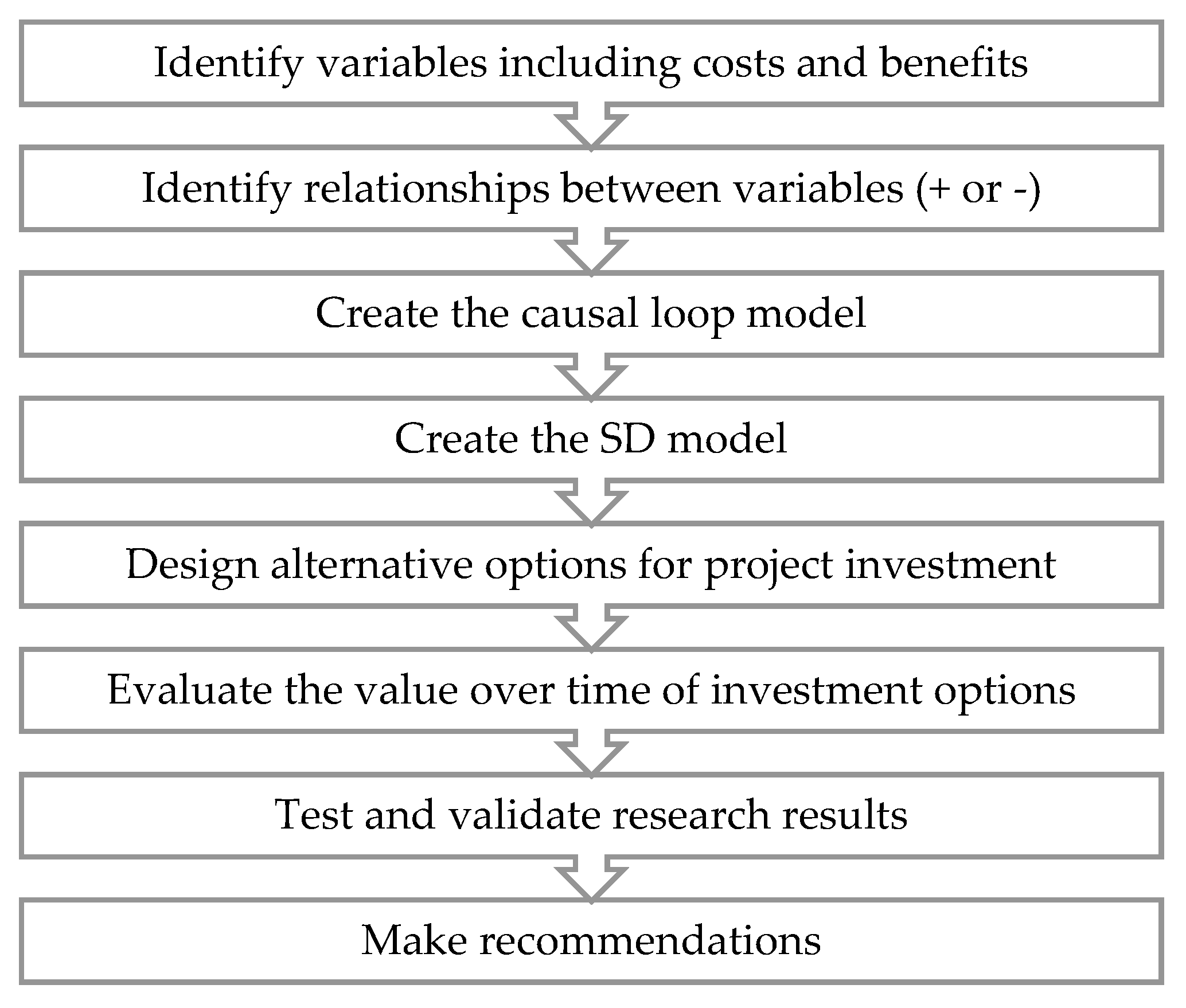
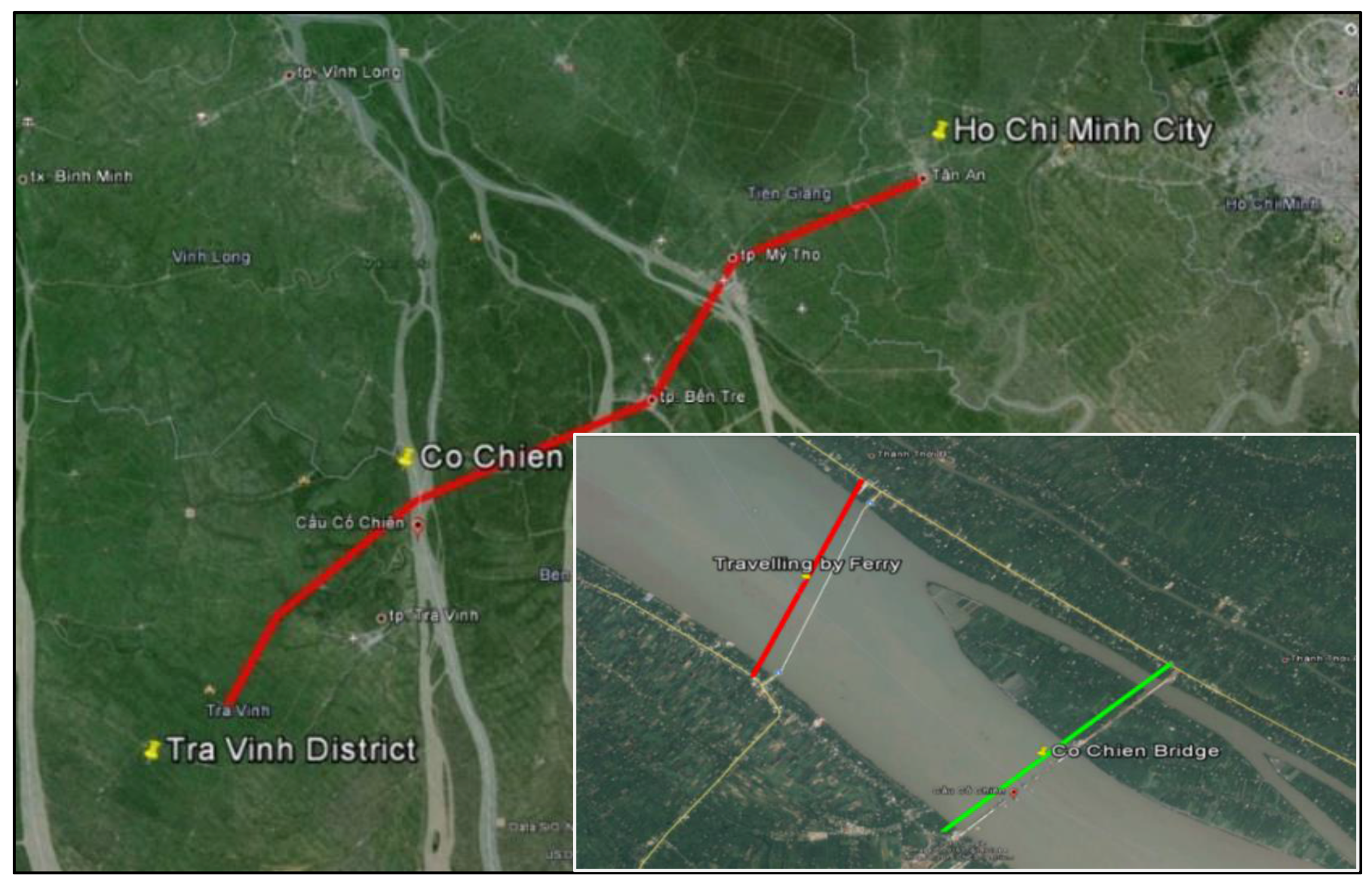
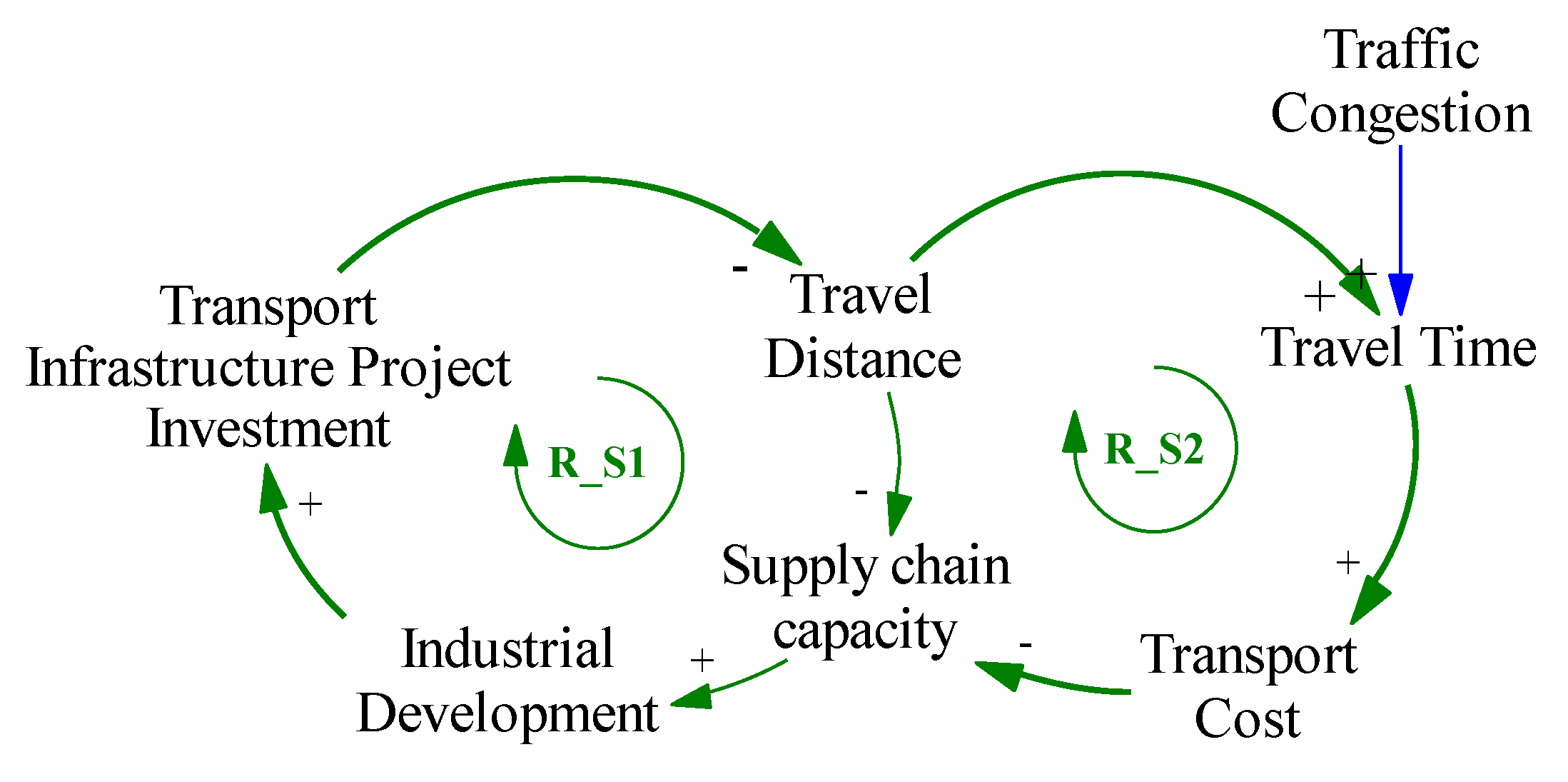
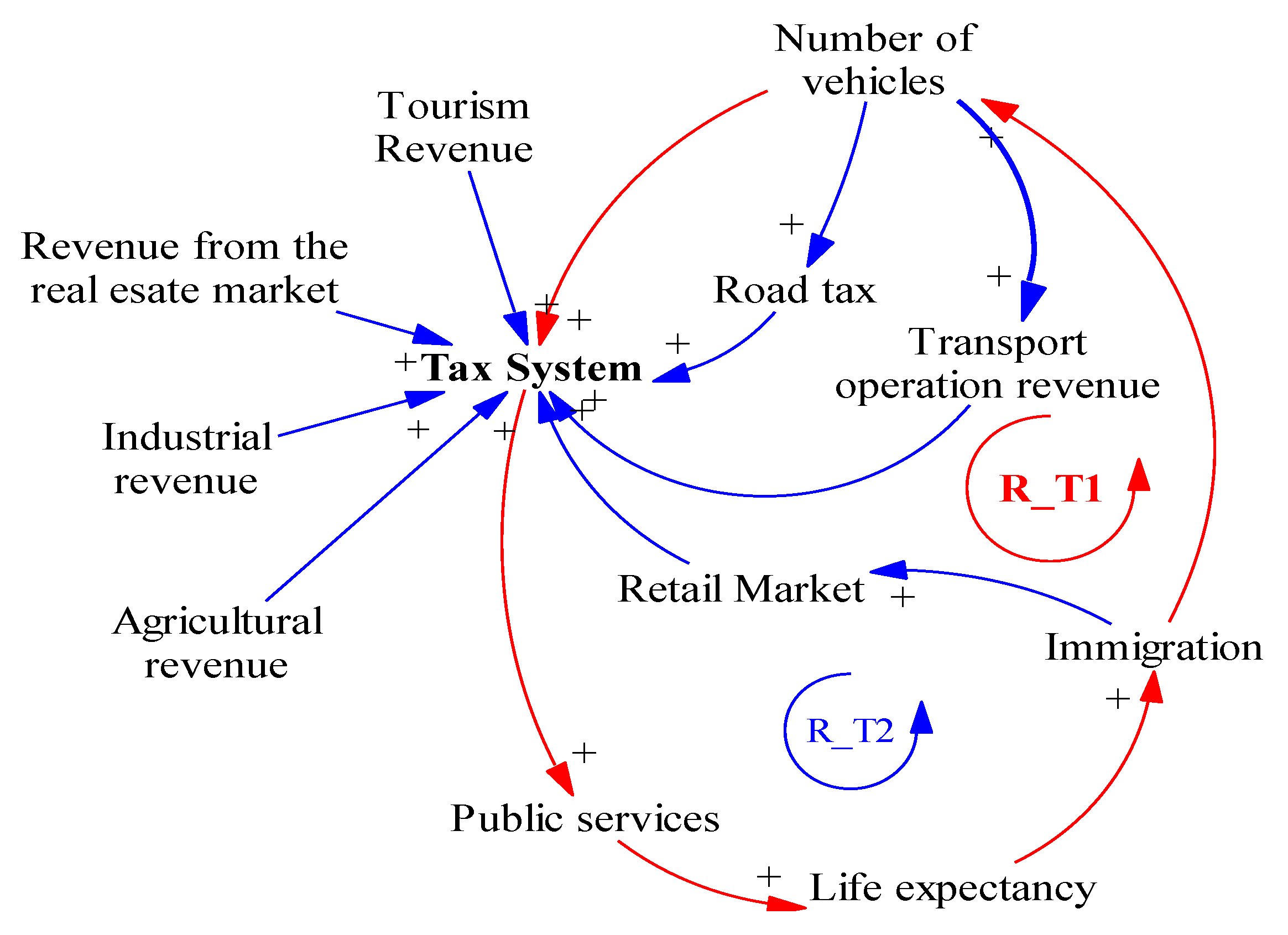
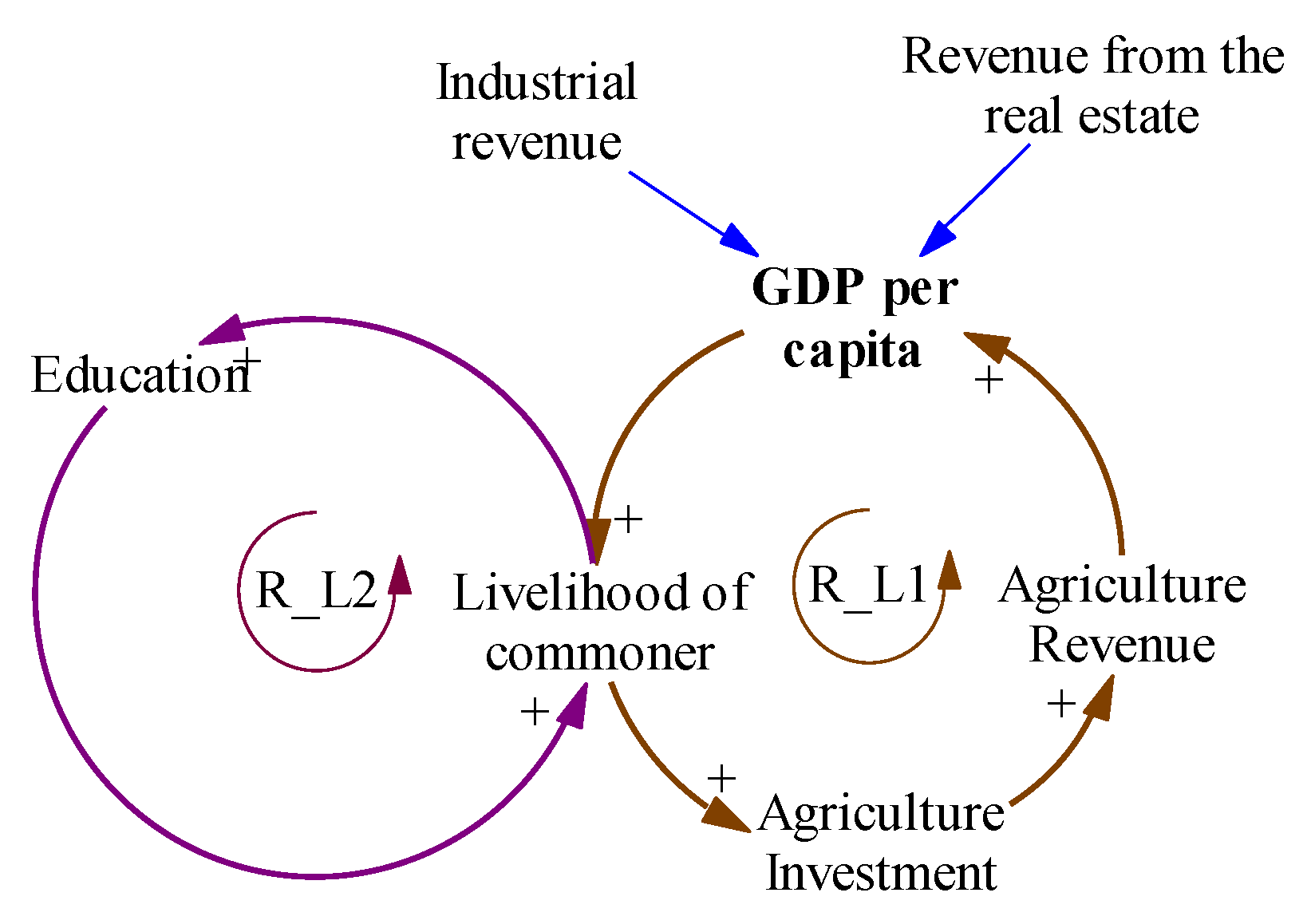
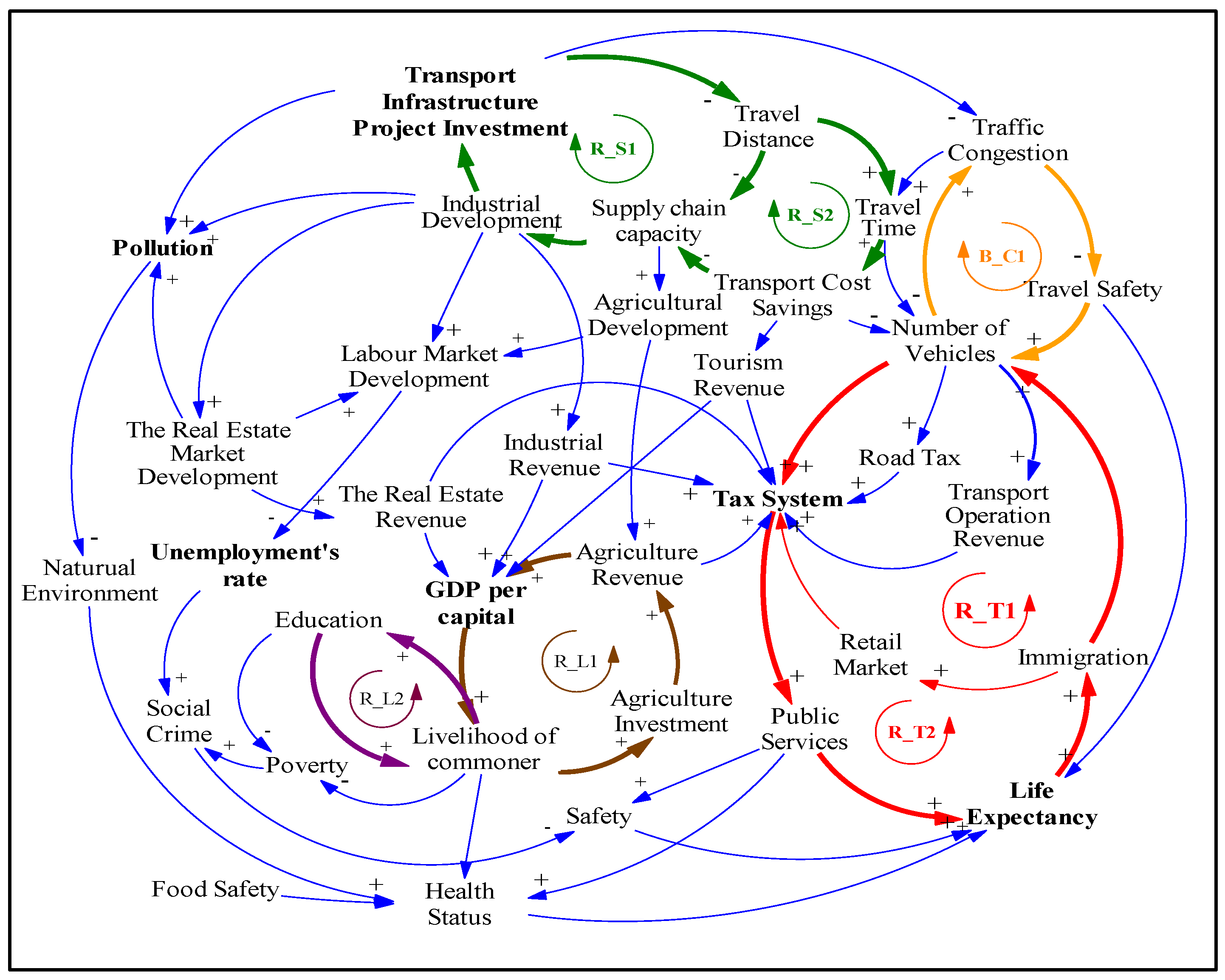
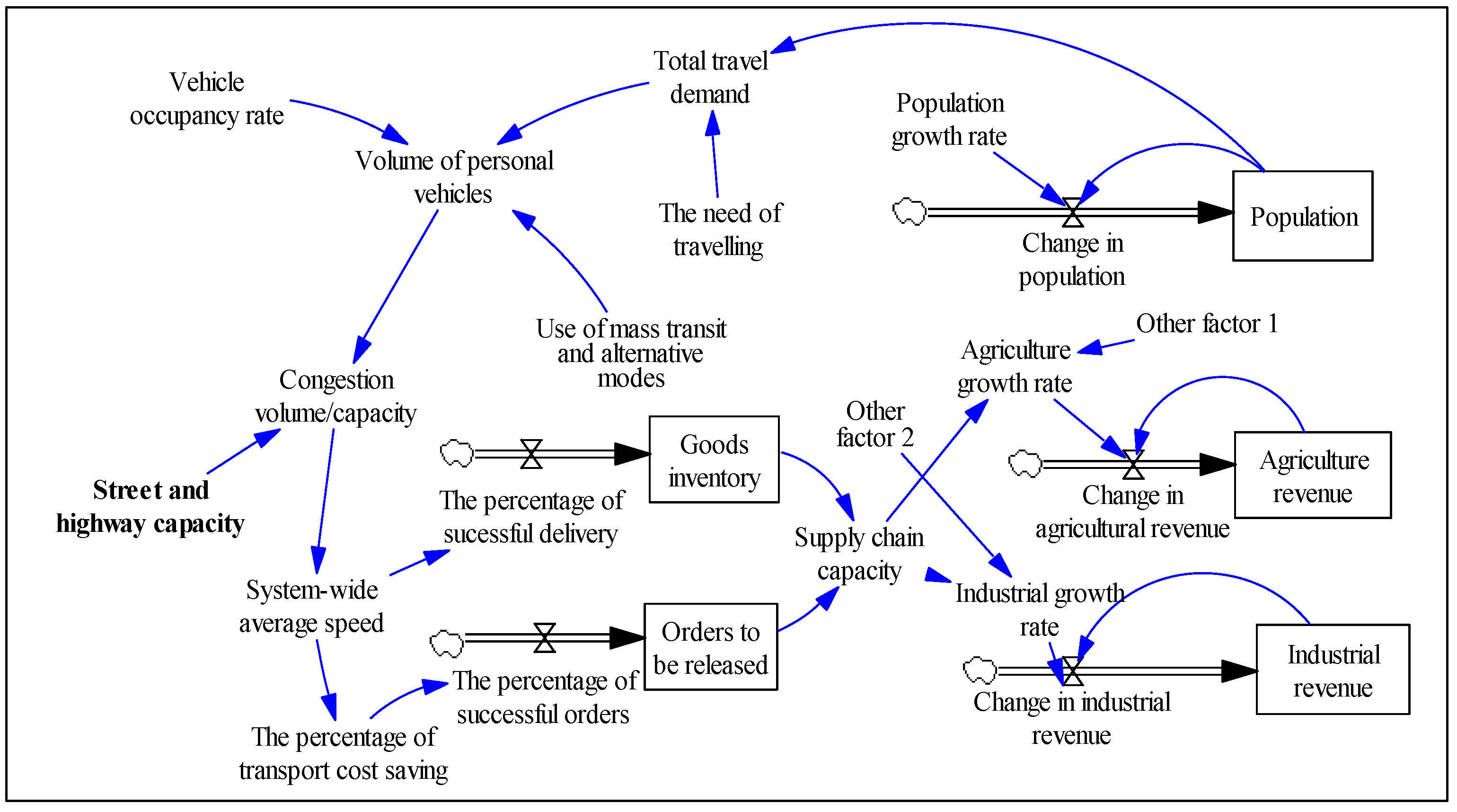
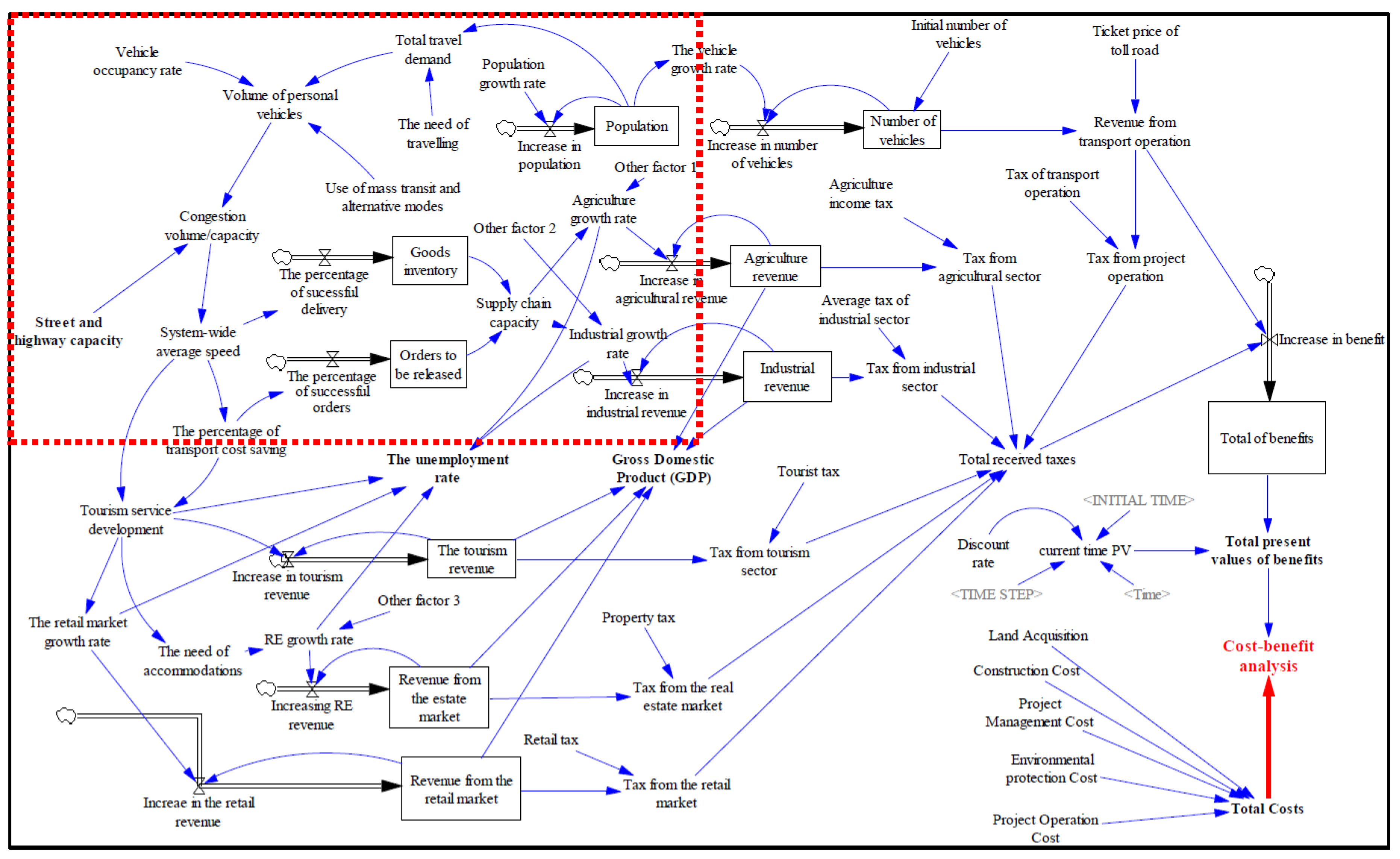



© 2017 by the authors. Licensee MDPI, Basel, Switzerland. This article is an open access article distributed under the terms and conditions of the Creative Commons Attribution (CC BY) license (http://creativecommons.org/licenses/by/4.0/).
Share and Cite
Nguyen, T.; Cook, S.; Ireland, V. Application of System Dynamics to Evaluate the Social and Economic Benefits of Infrastructure Projects. Systems 2017, 5, 29. https://doi.org/10.3390/systems5020029
Nguyen T, Cook S, Ireland V. Application of System Dynamics to Evaluate the Social and Economic Benefits of Infrastructure Projects. Systems. 2017; 5(2):29. https://doi.org/10.3390/systems5020029
Chicago/Turabian StyleNguyen, Tiep, Stephen Cook, and Vernon Ireland. 2017. "Application of System Dynamics to Evaluate the Social and Economic Benefits of Infrastructure Projects" Systems 5, no. 2: 29. https://doi.org/10.3390/systems5020029





